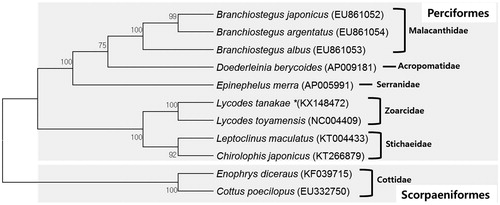Abstract
The complete mitochondrial genome of Lycodes tanakae was sequenced for the first time from its muscle tissue using the next-generation sequencing method. Its mitochondrial genome was 16,594 base pairs in length, containing 13 protein-coding genes, 22 transfer RNA genes, two ribosomal RNA genes, and one control region. Its overall A, C, G, and T contents were 25.6%, 30.6%, 18.7%, and 25.2%, respectively. Its, A + T content (50.8%) was slightly higher than its G + C content (49.2%). A phylogenetic tree was built using 10 belonging to the order Perciformes and two species belonging to the order Scorpaeniformes.
Lycodes tanakae Jordan and Thompson Citation1914 belongs to Perciform family Zoarcidae. They are known as benthic fishes with distribution in the East Sea, Northern part of Japan, and Russia (Jordan & Thomson Citation1914; Mori Citation1952; Sokolovskaya et al. Citation1998; Kim et al. Citation2005; Nakabo Citation2013). Lycodes tanakae (Jang-chi in Korean) is a commercially valuable fish species (Choi et al. Citation2013).
In the present study, L. tanakae specimen was collected from a commercial fish market (Mukho-port, Donghae-si) near the East Sea of Korea. The specimen was deposited at the National Marine Biodiversity Institute of Korea (MABIK PI00039362). We dissected the right dorso-lateral muscle of the specimen and preserved it in 95% ethanol. Genomic DNA was extracted from the sample using Qiagen DNeasy Blood and Tissue kit (Qiagen Korea Ltd, Seoul, South Korea) following the manufacturer’s instructions. The complete mitochondrial DNA was sequenced on a Hiseq2000 platform using next-generation sequencing (NGS) technique (Illumina, San Diego, CA). Geneious 9.1.3 (Biomatters Ltd, Auckland, New Zealand), tRNA Scan-SE1.21 software (http://lowelab.ucsc.edu/tRNA Scan-SE/), and MitoFish (Mitochondrial Genome Database of Fish, http://mitofish.aori.u-tokyo.ac.jp/) were used to assemble and annotate the mitochondrial DNA sequences.
The complete mitochondrial genome (GenBank Accession No. KX148472) was 16,594 base pairs in length. Its overall A, C, G, and T contents were, 25.6%, 30.6%, 18.6%, and 25.2%, respectively. Its A-T content (50.8%) was slightly higher than its G-C content (49.2%). This genome contained 13 protein-coding genes (ND1-ND6, ND4L, COI-COIII, ATP6, ATP8, and CYTB), 2 rRNA genes (12s and 16s RNA), 22 tRNA genes, and 1 D-loop region. Of protein-coding genes, the longest one was ND5 (1839 bp) and the shortest one was ATP8 (168 bp). The 12S and 16S rRNA genes were 946 bp and 1692 bp in length, respectively. They were interspaced by the tRNA gene tRNA-Val. Most genes of the mitogenome of L. tanakae were encoded on the L-strand except for the ND6 and tRNA (Gln, Ala, Asn, Cys, Tyr, Ser (UCN), Glu and Pro) genes which were encoded on the H-strand. All 13 protein-coding genes had the same start codon ATG except gene COI which had GTG as the start codon instead. However, the stop codons of the 13 protein-coding genes varied. Among the 13 protein-coding genes, four genes (COI, ATP8, ND4L, and ND6) had a stop codon of TAA, while ND1 and ND5 had a stop codon of TAG. ATP5 and COIII ended with TA– while and five genes (ND2, COII, ND3, ND4, and CYTB) ended with T––. These results might help elucidate further phylogenetic relationship among different species of Zoarcidae. The order and pattern of gene arrangement in this mitogenome were identical to those of other species in genus Lycodes (Miya et al. Citation2003, GenBank Accession No. AP004448, L. toyamensis, ). The mitogenome sequence of L. tanakae will provide useful information for understanding the evolutionary history and phylogenetic relationship for genus Lycodes within the family Zoarcidae.
Figure 1. A maximum parsimony (MP) tree using coding genes of complete mitochondrial genomes of L. tanakae and 10 species belonging to order Perciformes as well as 2 species belonging to order Scorpaeniformes. The complete mitogenomes were downloaded from GenBank (accession number shown after the scientific name of each species). The phylogenetic tree was constructed with MEGA 6 using 1000 bootstrap replicates.

Disclosure statement
The authors have no conflicts of interest to declare. The authors are solely responsible for the content and the writing of this paper.
Additional information
Funding
References
- Choi YM, Yoon BS, Kim HS, Park JH, Park KY, Lee JB, Yang JH, Sohn MH. 2013. Feeding habits of Lycodes tanakae in the coastal waters of the middle East Sea, Korea. Kor. J Fish Aquat Sci. 46:846–850.
- Jordan DS, Thompson WF. 1914. Record of fishes obtained in Japan in 1911. Mem Carneg Mus. 6:205–313.
- Kim IS, Choi Y, Lee YJ, Kim BJ, Kim JH. 2005. Illustrated book of Korean fishes. Seoul, Korea: Kyo-Hak Publishing. (in Korean).
- Sokolovskaya TG, Sokolovsky AS, Sobolevsky EI. 1998. A list of fishes of the Peter the Great Bay (the Sea of Japan). Voprosy Ikhtiologii. 38: 5–15.
- Miya M, Takeshima H, Endo H, Ishiguro NB, Inoue JG, Mukai T, Satoh TP, Yamaguchi M, Kawaguchi A, Mabuchi K, et al. 2003. Major patterns of higher teleostean phylogenies: a new perspective based on 100 complete mitochondrial DNA sequences. Mol Biol Evol. 26:121–138.
- Mori T. 1952. Check list of the fishes of Korea. Mem Hyogo Univ Agr. 1: 228.
- Nakabo T, editor. 2013. Family Zoarcidae. In: Hatooka K., editor, Fishes of Japan with pictorial keys to the species. 3rd ed. Hadano: Tokai University Press, pp. 1028–1044 (In Japanese).
